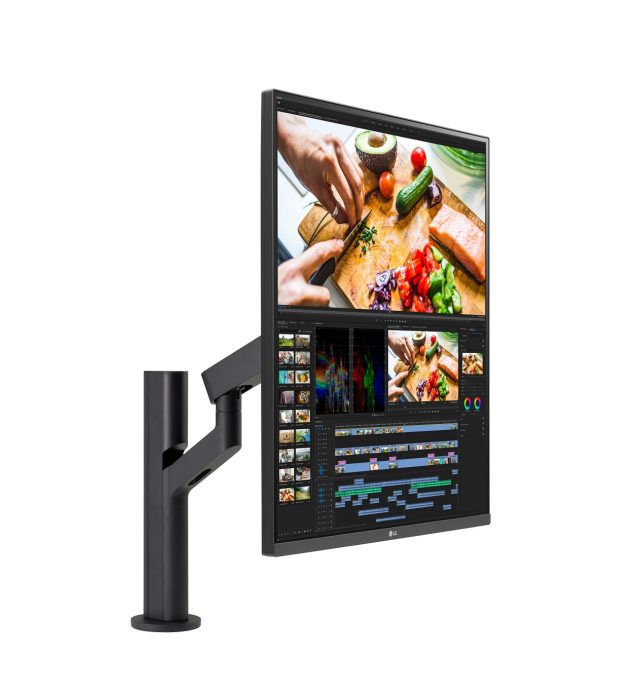
Every year, the Consumer Electronics Show previews a massive amount of products planned for release during the year. 2022's show revealed the latest in PC monitors targeting better image quality, faster refresh rates, and features that help facilitate increasingly virtual workplaces.
There was a lot to see, so we've broken down seven of the most interesting monitors announced at CES 2022 below. We've included no concepts, no gag releases, and no gimmicks (OK, maybe a few gimmicks). Regardless, none of these products should end up as vaporware.
Here's a look at some of the most unique monitors expected to come out over the next 12 months.
Asus ROG Swift 360 Hz PG27AQN

When Nvidia announced new RTX 3000-series graphics cards at CES, the company also promised 27-inch 1440p monitors that could hit 360 Hz to accommodate the new GPUs (today's fastest monitors can do 360 Hz but are limited to 1080p). Numerous brands announced 1440p 300 Hz monitors at CES, but Asus was the only one to take 1440p up to 360 Hz.
In its announcement, Asus said the ROG Swift 360 Hz PG27AQN is the fastest monitor the company has ever made "in terms of response time in real-world use." That means Asus' monitor should have extremely little ghosting. Unfortunately, Asus didn't confirm an official response time spec (we've asked about that and will update this article if we hear back). However, it did detail the new type of IPS (in-plane switching) technology it made with gaming display manufacturer AUO in order to achieve its speed.
"Response time" measures how long it takes for a monitor's pixels to turn from black to white and then black again, which happens when the display turns its liquid crystals to change the amount of light coming through. To get a faster response time on the PG27AQN, Asus made an IPS panel with liquid crystals carrying higher birefringence (basically, light refraction in two directions) and lower viscosity (or stickiness) to allow the liquid crystals to twist rapidly so light can pass through.
And instead of having liquid crystals that are parallel to the polarizer as usual, the crystals are slightly angled toward the polarizer, making them more efficient, Asus said.

The monitor also uses a dual-layer (instead of a single-layer) voltage drive. Rather than twisting liquid crystals by starting from the upper-left corner of the panel and working down to the bottom-right corner, the monitor twists liquid crystals by working from the upper-left and bottom-right corners simultaneously "for a smoother, more consistent image," Asus said.
Asus told Ars Technica that the price and release date for the PG27AQN is still to be determined.
Samsung Odyssey Neo G8

Time for more high-resolution speed. While the PG27AQN brings 1440p resolution to its highest refresh rate, the Samsung Odyssey Neo G8 will do the same for 4K resolution. We're not yet updating 8,294,400 pixels 360 times per second, but the Samsung Odyssey Neo G8 does hit a respectable 240 Hz.
The Odyssey Neo G8 is the first 4K monitor to claim a 240 Hz refresh rate and apparently uses compression to do it, since the monitor uses only HDMI 2.1 and DisplayPort 1.4 ports. Additionally, the gaming display claims a 1 ms gray-to-gray (GtG) response time.
If its premium resolution and speed aren't enough, Samsung also gave the monitor the most extreme curve you can find in a monitor— 1000R.
For a closer look at the screen, check out our article on the Odyssey Neo G8.
Samsung told us it would share the monitor's price and release date "later this year."
LG DualUp Monitor (28MQ780)

Most computer screens are wider than they are tall, but the last couple of years have seen laptops embracing screens with a bit more height than is typical. LG has taken the tall-screen trend even further by announcing a monitor with a 16:18 aspect ratio.
The 27.6-inch LG DualUp Monitor (28MQ780) is taller than any other consumer PC monitor. But it's notably closer to a square shape than the more traditional 16:9 monitor or an ultra-wide one.
With a 2560 x 2880 resolution, the DualUp gives you the same number of pixels as two 21.5-inch 16:9 monitors, making it an option for heavy productivity and those who just want more space for long newsfeeds.
You can read up on the DualUp by checking out our article on the announcement of LG's ultra-tall 28MQ780.
LG did not provide a specific price or release date.
reader comments
133